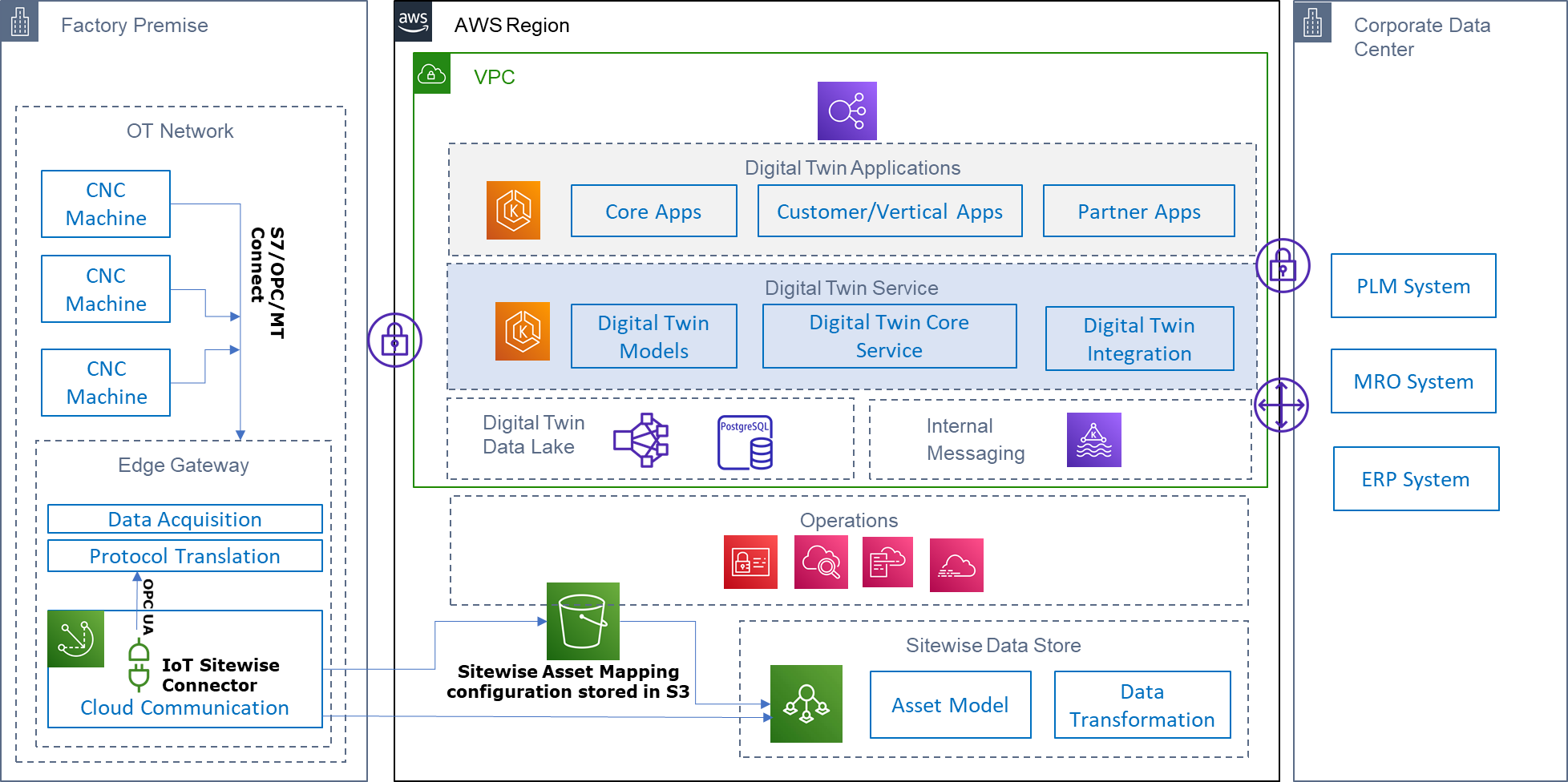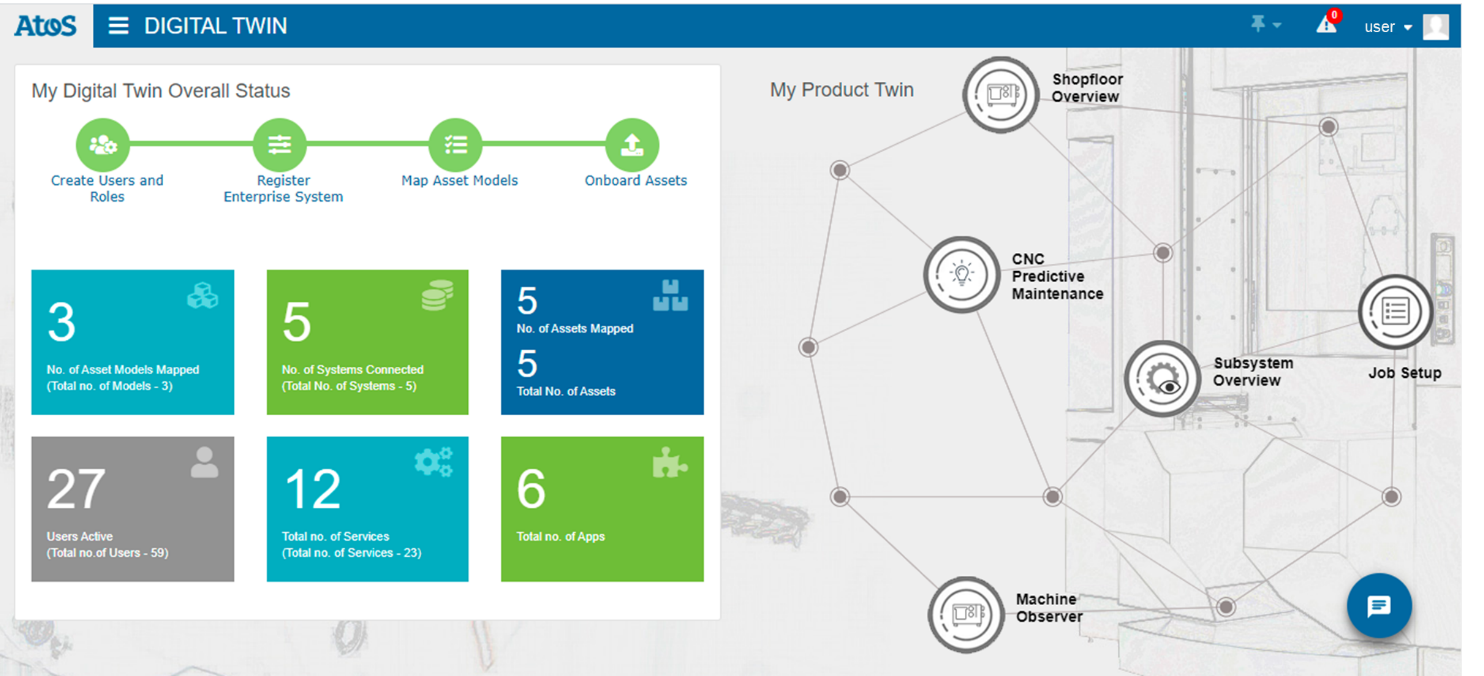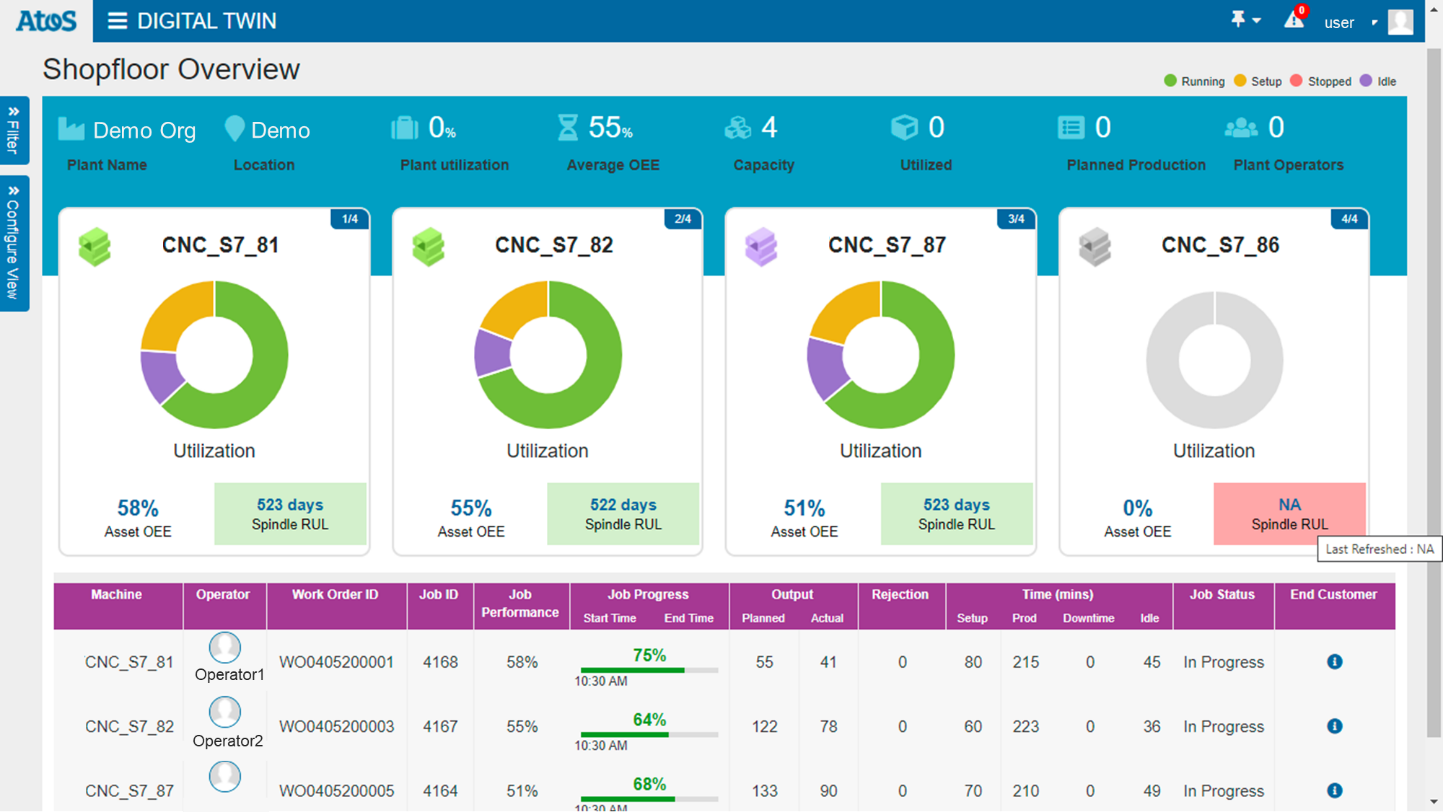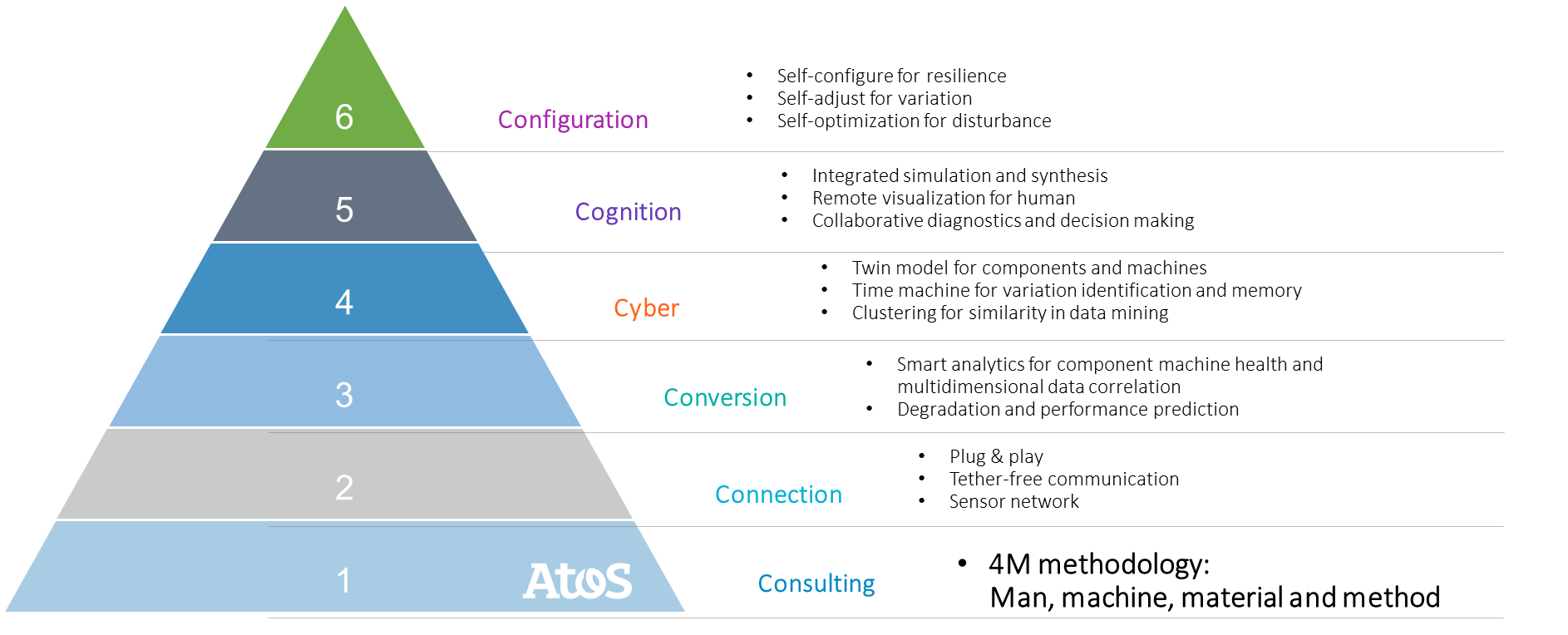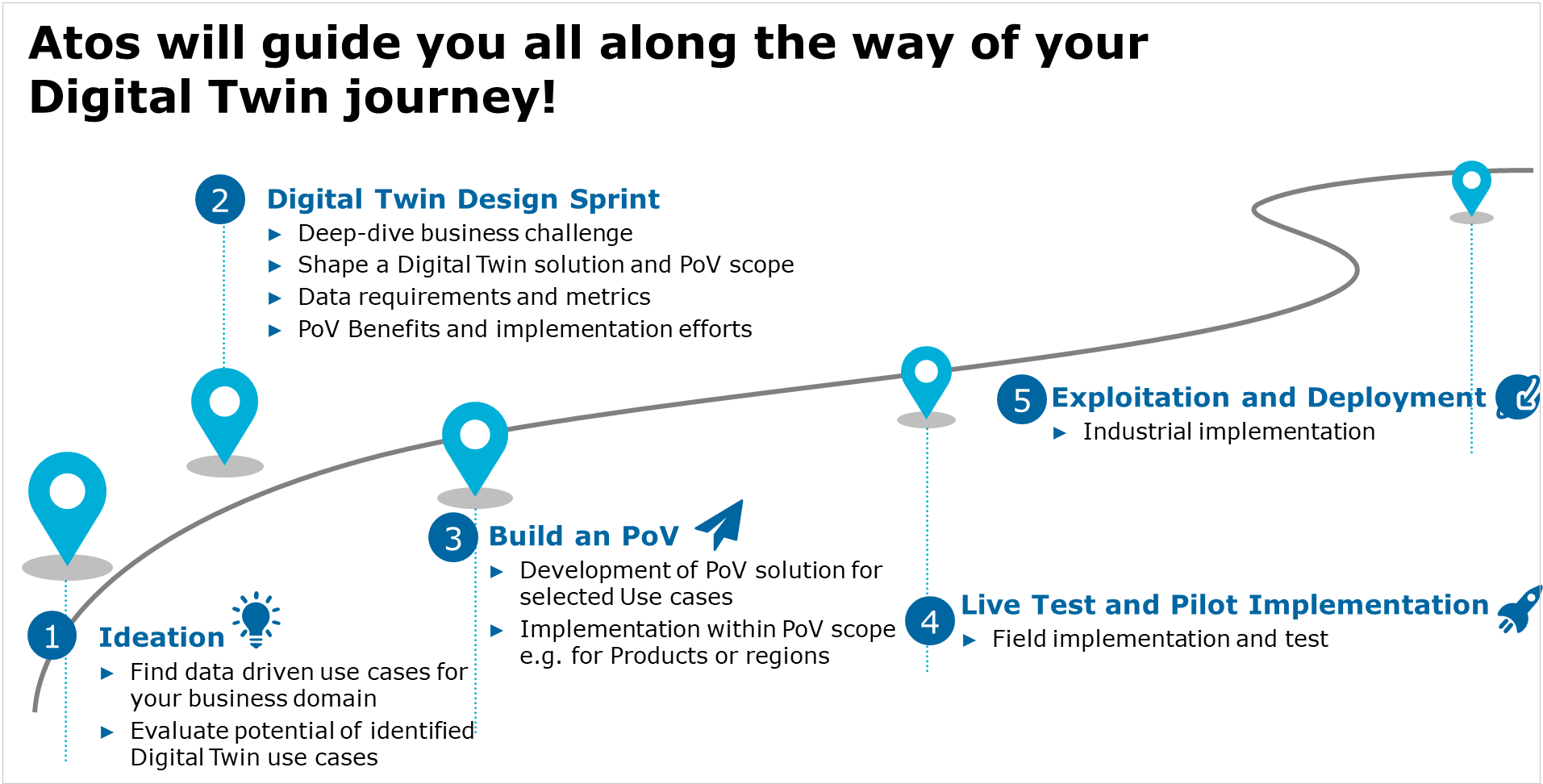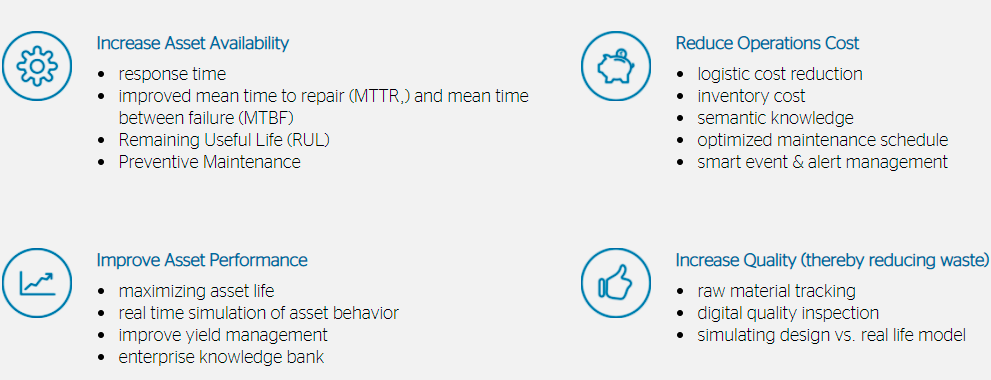AWS Partner Network (APN) Blog
Improving Productivity with Real-Time Insights from the Atos Digital Twin Platform for Shop Floor
By Kedar Joglekar, Technical Director – Atos
By Murli Mohan Srinivas, Digital Twin Business Leader – Atos
By Ramesh Ranganathan, Partner Solutions Architect – AWS
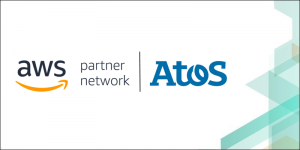 |
| Atos |
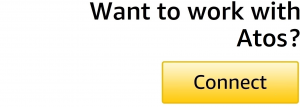 |
Customers across industries—especially in manufacturing, automotive, and energy—are looking to optimize business key performance indicators (KPIs) and outcomes throughout the product lifecycle.
Enterprises can achieve this goal by using real-time insights from industrial assets provided by their digital twins. This unique data-driven approach has evolved to become a critical tool for accelerating enterprise digital transformation.
However, one of the biggest challenges facing enterprises today is in the area of connectivity—gathering and integrating data from a wide variety of sources to build a cohesive view of their industrial assets.
Different data aspects of assets like design, maintenance, and state are modelled and managed by disparate enterprise systems such as PLM, APM, MRO, MES, and Internet of Things (IoT). These systems represent the digital threads which need to be brought together in a coherent way to provide a 360-degree view of the assets.
Digital twin is emerging as the new paradigm that combines data about assets and processes from different systems into one digital companion, or digital view. The continuous gathering and analysis of data through advanced statistical models and machine learning (ML) leads to an autonomous/decision making system, increasing asset availability, reduced operational costs, improved asset performance, and a step change in quality.
Physical assets, related production processes, and their virtual digital twins continue to improve by constantly learning from each other. This positively influences the top and bottom lines of many businesses.
This post provides an overview of the Atos Digital Twin Platform, its delivery methodology, the industry challenges it addresses, and the underlying reference architecture powered by Amazon Web Services (AWS). Atos is a an AWS Advanced Consulting Partner and Managed Service Provider (MSP).
The Atos Solution to Business Challenges
A digital twin is a virtual replica of a physical product—both in terms of model representation and behavior with mutual interaction, providing closed-loop feedback.
As a result, it’s possible to effectively monitor, optimize, and automate improvements in products and services delivered by businesses across the entire value chain. This includes designing, prototyping, manufacturing, and supply chain to support an organization’s digital transformation journey.
Figure 1 – Atos Digital Twin Platform overview.
The Atos Digital Twin Platform—with its building blocks of data integration, industry-agnostic cloud platform, and extendable APIs—provides acceleration to deliver key digital twin functionalities. This covers data acquisition, data modelling, data standardization (IEC/ISO specific), application development, and enterprise connectivity.
A complete view of the asset or process is available to support development of further verticalized applications. This uses built-in visualization, business logic, and backend integration specific to the needs of an industry or customer.
Atos, from its system integrator perspective, groups all digital threads into three data pillars: enterprise data (IT systems), field data (operational technologies (OT)/sensor/instrument data), and semantic data (ST – ontology thread capturing human expert knowledge through knowledge graphs). This provides insights on assets and addresses use cases such as performance monitoring, remaining useful life (RUL), and root cause analysis, to name a few.
The Atos Digital Twin Platform has been customized and pre-integrated to provide turnkey solutions in several industries.
Atos Digital Twin Platform for Manufacturing Shop Floor
Improving manufacturing KPIs through process optimization has been an ongoing concern for several decades.
Although enterprise IT applications such as SCM, MES, ERP, and other shop floor solutions benefit from underlying data models that are quite standard, PLCs, controllers, and SCADA systems are diverse and proprietary. This means data extraction, aggregation, and harmonization continue to present the biggest challenge for most solution providers.
The Atos solution addresses these problems by accelerating data collection and by contextually bringing in IT-OT convergence from shop floor assets. Platform monitoring and analytical capabilities detect potential issues and provide insights about overall equipment efficiency (OEE).
Atos Digital Twin Platform for Energy and Utility
For the energy and utility sector, digital twin assumes immense importance because maximizing performance output from large capital investments is a major competitive advantage.
Asset performance is linked to engineering design, external environmental conditions, and human behavior and actions. Addressing this multi-dimensional relationship requires creation of a digital twin meta model so advanced analytics can be performed to match supply with demand.
The Atos solution for wind energy provides predictability of asset availability and performance. It does so by monitoring KPIs and by supporting service engineers in improving mean time to repair (MTTR) and mean time between failure (MTBF), thereby enhancing overall asset availability.
The Digital Twin solutions for both the shop floor and energy are industry-specific solution accelerators that have been pre-packaged based on learnings from customer engagements. These can significantly accelerate and maximize value from IT and OT digital threads.
The Atos Digital Twin solution is built using AWS services and uses AWS IoT SiteWise to collect, organize, and store industrial equipment data. This enables quick integration with a customer’s on-premises OT systems and frees up developers and architects to focus on business logic.
Digital Twin Solution for Shop Floor Architecture
The following reference architecture (Figure 2) describes the Atos Digital Twin solution for shop floor powered by AWS. It comprises three main areas: on-premises data collection, integration with enterprise information systems, and the Atos Digital Twin Platform providing a central data lake and processing.
Figure 2 – Digital twin for shop floor reference architecture.
The key components of Atos Digital Twin Platform are:
- Edge gateway is the infrastructure deployed on the factory floor using AWS IoT Greengrass and AWS IoT SiteWise. It provides a connectivity solution to collect data from shop floor equipment like CNC machines using the industry-standard OPC UA protocol. The architecture is extensible to support additional protocol and translation middleware that can be used to incorporate data collection from a variety of industrial assets that do not directly support OPC UA.
- The Atos Digital Twin services and data lake provide the components to store, analyze, and visualize the data and business KPIs in real-time:
- The Digital Twin data lake provides hot storage of raw data and KPIs using Amazon Relational Database Service (Amazon RDS), analytics capability for computing KPIs using Amazon EMR, and cold storage and archival of raw data in Amazon Simple Storage Service (Amazon S3).
- The Digital Twin messaging component provides internal integration with high throughput using Amazon Managed Streaming for Apache Kafka (Amazon MSK).
- Digital twin services provide well-defined APIs for the digital twin applications to consume data and insights. These services are deployed as containers on Amazon Elastic Kubernetes Service (Amazon EKS).
- Digital twin applications comprise core applications which provide default functionalities like model service or asset overview and vertical or partner applications. These provide industry-specific solutions based on Digital Twin services.
- The integration component from the Digital Twin service layer enables IT-OT data mapping and integration by providing connectivity to enterprise systems using standards such as REST APIs. Enterprise data from PLM/SLM, MRO, and ERP systems are the most common sources of IT data.
Data is collected from CNC machines through their controller interface by a protocol translator and data aggregator, which helps connect multiple machines and support different protocols. The Digital Twin edge solution reads the data from middleware using AWS IoT SiteWise connector deployed on AWS IoT Greengrass, and pushes the data to the cloud.
AWS IoT SiteWise maps the data tags collected from the OT layer with the logical asset model on the cloud to create a central data store. Data collected is stored in the AWS IoT SiteWise datastore and is used by Digital Twin services using SiteWise APIs. To quickly onboard OT assets, tag information is exported to S3 and automatically mapped with the asset model.
The Atos Digital Twin Platform is aligned with the AWS Well-Architected Framework and provides a resilient, high-availability platform. The platform uses scalable and extendable infrastructure, providing the ability to extend resources on-demand to handle additional data or application loads.
The architecture supports industry standards including OPC UA, REST, and HTTPS to integrate, and provides open standard-based APIs to extend and customize pre-built solution and use case functionality.
Digital Twin Solution for Shop Floor – Dashboards
Atos Digital Twin dashboards provide key insights into your shop floor assets and help you monitor the business KPIs in real-time.
The status dashboard provides an overview of the number of connected assets, users, and applications. The dashboard reflects status in real-time as new assets and assets models get onboarded.
Figure 3 – Digital twin overall status dashboard.
The shop floor overview dashboard provides real-time views into key KPIs at the asset level, like remaining useful life (RUL), asset OEE, or job performance.
Figure 4 – Digital twin shop floor asset overview dashboard.
Atos Solution Delivery Methodology
Atos has developed a Digital Twin consultative approach (4M-6C methodology) to engage with stakeholders to identify the key influencers that impact business outcomes from the intended customer use case.
Here, 4M (man, machine, material, method) focuses on capturing and benchmarking influencers of business KPIs, while 6C (consulting, connectivity, conversion, cyber, cognition, configuration) are related to the maturity of the digital twin model.
Understanding these business KPIs and their influencing factors is critical to identifying the different digital threads required.
Figure 5 – Atos 4M-6C Methodology.
This established methodology provides an agile roadmap approach that enables a long-term view and phased delivery to de-risk implementation complexities while learning and adapting to change.
The ideation workshop is conducted during the initial stage to bring all stakeholders together to document the key requirements, identify pain points, influencers, and challenges which define subsequent use cases as an outcome of the workshop. For example, in the machine area a particular use case could be related to reducing MTTR by 10% or increasing OEE by 5%.
Figure 6 – Digital Twin customer journey.
Based on use case prioritization, Atos subsequently defines the data threads that help complete the “how” part (6C) and access the maturity model of digital twin.
The customer journey continues after the ideation workshop into an iterative and collaborative approach to build and customize the Atos Digital Twin Platform to fit specific use cases, assets, or KPIs. It starts with a proof of value, moves towards pilot rollout, and concludes with the industrialization of the solution across regions and plants, or by incorporating additional use cases.
The combination of the solution and the Atos engagement methodology provides a scalable, extendable accelerator that helps project teams focus more on solving the business problems identified.
Solution Benefits
Atos’s Digital Twin Platform is a preconfigured, cloud-native, and multi-industry vertical platform that’s accompanied by a proven consulting approach for rapid customer onboarding and time to value.
In wind farm management, the solution has proven to help clients optimize their operations and increase asset availability through the insights it generates. Realized benefits include a 20% improvement in mean time to repair (MTTR), 12% lower operational costs, and increased asset uptime.
Figure 7 – Atos Digital Twin Platform benefits.
Conclusion
Atos Digital Twin Platform powered by Amazon Web Services brings best-of-breed services from both Atos and AWS. The Atos platform, system integration, consulting approach and industry expertise combine with highly scalable and secure cloud services from AWS provide a state-of-the-art solution that accelerates enterprise digital transformation using digital twin concepts.
For additional information and to learn how the Atos Digital Twin Platform can be applied to your industry requirements, visit the Atos Digital Twin page.
The content and opinions in this blog are those of the third-party author and AWS is not responsible for the content or accuracy of this post.
Atos – AWS Partner Spotlight
Atos is an AWS Consulting Partner and MSP that is a leader in digital services and believes bringing together people, business, and technology is the way forward.
Contact Atos | Partner Overview
*Already worked with Atos? Rate the Partner
*To review an AWS Partner, you must be a customer that has worked with them directly on a project.

